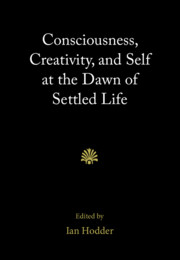Book contents
- Consciousness, Creativity, and Self at the Dawn of Settled Life
- Consciousness, Creativity, and Self at the Dawn of Settled Life
- Copyright page
- Contents
- Contributors
- Acknowledgments
- Part I Introduction to the Themes, Site, and Region
- Part II Higher Levels of Consciousness
- 3 When Time Begins to Matter
- 4 Cognitive Change and Material Culture
- 5 Conscious Tokens?
- 6 Brick Sizes and Architectural Regularities at Neolithic Çatalhöyük
- Part III Greater Innovation and Creativity
- Part IV Greater Awareness of an Integrated Personal Self
- Notes
- Index
- References
5 - Conscious Tokens?
from Part II - Higher Levels of Consciousness
Published online by Cambridge University Press: 22 February 2020
- Consciousness, Creativity, and Self at the Dawn of Settled Life
- Consciousness, Creativity, and Self at the Dawn of Settled Life
- Copyright page
- Contents
- Contributors
- Acknowledgments
- Part I Introduction to the Themes, Site, and Region
- Part II Higher Levels of Consciousness
- 3 When Time Begins to Matter
- 4 Cognitive Change and Material Culture
- 5 Conscious Tokens?
- 6 Brick Sizes and Architectural Regularities at Neolithic Çatalhöyük
- Part III Greater Innovation and Creativity
- Part IV Greater Awareness of an Integrated Personal Self
- Notes
- Index
- References
Summary
Small, geometric-shaped clay objects (spheres, discs cones, etc.) are a common feature of all occupational levels at Çatalhöyük. Crudely manufactured in the context of the site’s material culture, clay objects are generally disposed of after little use, in middens. Clay objects appear at the start of the Neolithic across the wider Near East. They are the most prevalent artefact at neighbouring ninth to eight millennium BC Boncuklu Höyük, for example, and remain common across Anatolia and the Near East into the first millennium BC. It is largely assumed that from their inception, clay objects acted as “tokens”, used as part of a formal, settlement wide and intersettlement mnemonic record-keeping system, consistent across the entire Near East for millennia. Their sudden appearance in the Neolithic was necessitated by the simultaneous shift in lifestyle from mobile hunter-gather to sedentary farming communities. It is further argued (Schmandt-Besserat 1992a, 1992b, 1996) that it is only after the cognitive shift into the modern, civilised mind that humans become capable of counting, recording and conceiving of abstract numbers. In this theoretical context, the presence of “tokens” at a settlement is clear evidence for the presence of a highly organised, intelligent, cognitively “advanced” population.
- Type
- Chapter
- Information
- Consciousness, Creativity, and Self at the Dawn of Settled Life , pp. 107 - 132Publisher: Cambridge University PressPrint publication year: 2020



